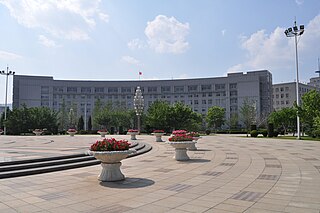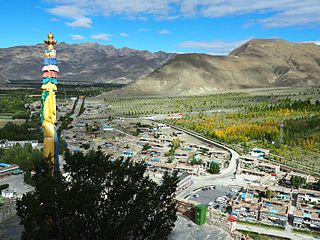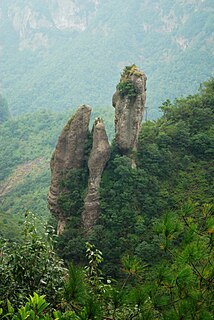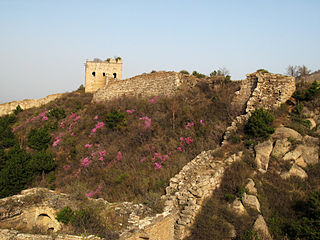
The Three Gorges are three adjacent gorges along the middle reaches of the Yangtze River, in the hinterland of the People's Republic of China. With a subtropical monsoon climate, they are known for their scenery. The "Three Gorges Scenic Area" is classified as a AAAAA scenic area by the China National Tourism Administration.

Anyang is a prefecture-level city in Henan province, China. The northernmost city in Henan, Anyang borders Puyang to the east, Hebi and Xinxiang to the south, and the provinces of Shanxi and Hebei to its west and north respectively.

Zhangjiakou also known by several other names, is a prefecture-level city in northwestern Hebei province in Northern China, bordering Beijing to the southeast, Inner Mongolia to the north and west, and Shanxi to the southwest. At the 2010 census, its population was 4,345,485 inhabitants on 36,861.56 square kilometres (14,232.33 sq mi), divided into 17 Counties and Districts. The built-up area made of Qiaoxi, Qiaodong Districts and Wanquan County largely being conurbated had 838,978 inhabitants in 2010 on 1,412.7 km2 (545.4 sq mi). Due to its position on several important transport arteries, it is a critical transport node for travel between Hebei and Inner Mongolia and connecting northwest China, Mongolia, and Beijing.

Huanglong is a scenic and historic interest area in the northwest part of Sichuan, China. It is located in the southern part of the Minshan mountain range, 370 kilometres (230 mi) north-northwest of the capital Chengdu. This area is known for its colorful pools formed by calcite deposits, especially in Huanglonggou, as well as diverse forest ecosystems, snow-capped peaks, waterfalls and hot springs. Huanglong is also home to many endangered species including the giant panda and the Sichuan golden snub-nosed monkey. Huanglong was declared a World Heritage Site by UNESCO in 1992.

Jiuzhaigou is a nature reserve and national park located in the north of Sichuan Province in the southwestern region of China. A long valley running north to south, Jiuzhaigou was inscribed by UNESCO as a World Heritage Site in 1992 and a World Biosphere Reserve in 1997. It belongs to the category V in the IUCN system of protected area categorization.

Pingdingshan, also known as the Eagle City, had 4,904,701 inhabitants at the 2010 census whom 1,756,333 lived in the built-up or metropolitan area including Ye county. It is a prefecture-level city in central Henan province, China.

Jiaozuo is a prefecture-level city in northern Henan province, China. Sitting on the northern bank of the Yellow River, it borders the provincial capital of Zhengzhou to the south, Xinxiang to the east, Jiyuan to the west, Luoyang to the southwest, and the province of Shanxi to the north.Jiaozuo is one of the core cities of the Central Plains urban agglomeration and a regional central city in the Jin-Yu border area.link

Zhuanghe is one of the two "northern county-level cities", the other being Wafangdian, under the administration of Dalian, located in the south of Liaoning province, People's Republic of China. Its area is 3,655.70 square kilometres (1,411.47 sq mi) and its permanent population as of 2010 is 841,321, making it Dalian's most spacious county-level division.

Shannan, also transliterated from Tibetan as Lhoka, is a prefecture-level city in the southeastern Tibet Autonomous Region, China. Shannan includes Gonggar County within its jurisdiction with Gongkar Chö Monastery, Gonggar Dzong, and Gonggar Airport all located near Gonggar town.

The Taihang Mountains are a Chinese mountain range running down the eastern edge of the Loess Plateau in Shanxi, Henan and Hebei provinces. The range extends over 400 kilometres (250 mi) from north to south and has an average elevation of 1,500 to 2,000 metres. The principal peak is Xiao Wutaishan. The Taihang's eastern peak is Cangyan Shan in Hebei; Baishi Mountain forms its northern tip.

Tianchi is an alpine lake in Xinjiang, Northwest China, situated at 43°53′9.7″N88°7′56.6″E. The name (天池) literally means Heavenly Lake and can refer to several lakes in mainland China and Taiwan. This Tianchi lies on the north side of the Bogda Shan range of the Tian Shan, about 30 kilometres (19 mi) south of Fukang and 45 kilometres (28 mi) east of Ürümqi. It is an alpine drift lake shaped in the Quaternary Glacier period.
The Wei River of Shandong Province is a 283-kilometre (176 mi) long tributary of the Hai River. Beginning in the southern foothills of the Taihang Mountains in Xinxiang County of Henan Province, the Wei River meets the Grand Canal at Linqing in northwest Shandong province and more or less parallels the Yellow River at some distance for a several kilometers before flowing into the Hai River near Tianjin.

Xinxiang County is a county in Xinxiang, Henan Province. It is situated in the center of the northern Henan Plateau. The Taihang Mountains are to the north, and the Yellow River is to the south. The area is 365 km2 (141 sq mi) with a population of 310,000 in 2002. The postal code is 453700.

The Gold Coast hinterland is an area of South East Queensland, Australia that comprises the Tweed Range, Nimmel Range, Tamborine Mountain, Numinbah Valley, eastern parts of the McPherson Range and western parts of suburban Gold Coast, such as Mudgeeraba. This undefined unit of area is known for its tourist attractions including resorts, rainforest, lookouts, national parks, its diversity of fauna and flora and as a green backdrop to the coastal strip. It overlaps part of the Scenic Rim and is part of both the City of Gold Coast and Scenic Rim Region and includes Springbrook, Binna Burra and O'Reilly's Guesthouse.

Wutong Mountain (Chinese: 梧桐山; pinyin: Wútóng Shān; Hong Kong Hakka: Ng2tung2 san1) is a mountain located near the border of Luohu and Yantian in Shenzhen, China. At 943.7m, it is the tallest mountain in Shenzhen. The mountain is also source of the Shenzhen River.

The Guoliang Tunnel (Chinese: 郭亮洞) is carved along the side of and through a mountain in China. The tunnel links the village of Guoliang to the outside through the Taihang Mountains which are situated in Huixian, Xinxiang, Henan Province of China.

The Yuntai Mountain is situated in Xiuwu County, Jiaozuo, Henan Province of People's Republic of China. The Yuntai Geo Park scenic area is classified as a AAAAA scenic area by the China National Tourism Administration.

Yandang Mountains or Yandangshan refers, in the broad sense, to a coastal mountain range in southeastern Zhejiang province in eastern China, covering much of the prefecture-level city of Wenzhou and extending to the county-level city of Wenling in Taizhou prefecture. The mountain range is divided in two by the Oujiang River, the two parts being the North Yandang and South Yandang. More narrowly, Yandangshan is also used more narrowly to refer to Mount Yandang, a specific part of the North Yandang around an ancient caldera near a small town of the same name. The highest peaks of North Yandang are located here, and this is also the main tourist spot. In this article, name "Yandang Mountains" is used to refer the mountain range and "Mt. Yandang" to refer to the caldera.

The Zhangye National Geopark is located in Sunan and Linze counties within the prefecture-level city of Zhangye, in Gansu, China. It covers an area of 322 square kilometres (124 sq mi). The site became a quasi-national geopark on April 23, 2012. It was formally designated as "Zhangye National Geopark" by the Ministry of Land and Resources on June 16, 2016 after it has passed the on-site acceptance test. Known for its colorful rock formations, it has been voted by Chinese media outlets as one of the most beautiful landforms in China.

Baishi Mountain, also known by its Chinese name Baishishan, is a mountain in Laiyuan County, Baoding Prefecture, Hebei Province, China. Its highest peak has an elevation of 2,096 meters (6,877 ft) and its main ridge stretches for over 7,000 meters (22,966 ft). Parts of the Great Wall snake around its foothills. Baishi Mountain forms the northern end of the Taihang Chain and is located about 200 kilometers (120 mi) southwest of Beijing.






















